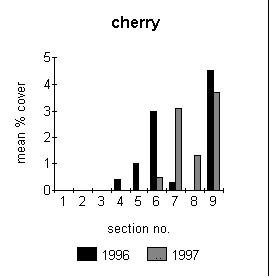.
For more illustrations of belt transect data, visit the wetland survey pages. Click here
3. STRATIFIED SAMPLING
Stratified sampling is used to take into account different areas (or strata) which are
identified within the main body of a habitat. These strata are sampled separately from the
main part of the habitat. The name 'stratified sampling' comes from the term 'strata'
(plural) or stratum (singular). For ease of understanding, the term 'unit' will be used in
the following explanation, rather than stratum.
Individual habitats are rarely uniform throughout their extent. There are often smaller
identifiable areas within a habitat which are substantially different from the main part
of the habitat. For example, scrub patches within a heathland area, or areas of
bracken in a grassland.
One of the problems with random sampling is that random samples may not cover all areas
of a habitat equally. To continue with the example of bracken patches in a grassland, if
the area was random sampled, it is possible that none of the samples might fall within the
bracken patches. The results would then not show any bracken in the habitat. Clearly this
would not be an accurate reflection of the habitat. In this sort of situation, stratified
random sampling would be used to avoid missing out on important areas of the habitat. This
simply means identifying the bracken as a different unit within the habitat and then
sampling it separately from the main part of the habitat.
While the bracken area clearly needs to be taken into account, it is nevertheless
important to avoid overemphasising its significance within the habitat as a whole. Its
importance is kept in context by locating a proportional number of samples directly within
the bracken unit. The proportion of samples taken within the unit is determined by the
area of the unit in relation to the overall area of the habitat.
For example, say the grassland area is 200 m2
overall, with the bracken patch occupying 50 m2
of this total area. The bracken therefore accounts for 25% of the total grassland area.
Say it has been decided that a total of 12 samples need to be taken in order to accurately
reflect the composition of the whole habitat. Then 3 of those samples (one quarter, or
25%) would be located within the bracken unit and 9 (three quarters, or 75%) in the
general grassland area.
There is a standard formula for calculating the number of samples to be placed in each
unit. This is:

For example, in the illustration given above this would be:

Which type of sampling to use? |


